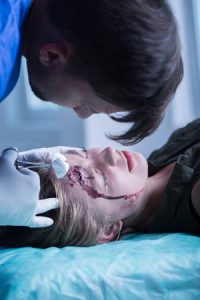
Facial wounds are a real chore for emergency room surgeons and others like dermatologic surgeons who may continue seeing an accident patient long after the first E.R. visit.
For one, traumatic facial wounds can end up in disfiguring scars. Narrow needles and sutures are needed so “needle tracks” and suture marks are not left on patient faces.
But Mohammed Al azrak, Mbbch, (Bachelor of Medicine and Surgery), FACs from the Burn and Plastic Surgery Unit at Fayoum General Hospital in Egypt and Rei Ogawa, MD, PhD in the Department of Plastic, Reconstructive & Aesthetic Surgery at Nippon Medical School in Tokyo studied using patients’ hair as sutures to close facial wounds.
The authors knew that when attending to traumatic facial wounds in females, it’s necessary to try and conserve their aesthetic appearance.
So that feminine beauty can be better preserved after injuries or accidents, one of the most important items is the thread used in stitching human skin. Hair, as it turns out, has an extremely small diameter (.06 to 0.1 millimeters.) One millimeter is as wide as the period at the end of this sentence.
Thus, Doctors Al azak and Ogawa organized a test, suturing women patients’ own hair to close facial wounds encountered from 2009 to 2016. Fifty-four women from age three to 45 years old had 56 traumatic wounds closed with their own scalp hair.
According to the two doctors, using females scalp hair did not bring about any unusual reactions in skin.
Once scalp hair was harvested, doctors dipped the hair/sutures into alcohol and then looked closely at the wound, check ing for:
- Nerve injury
- Blood vessel damage
- The state of ducts, muscles and other bodily structures.
The doctors asked if the patients had any systemic disorders like diabetes or if previous wounds left behind scars.
A very fine 30-gauge needle (about as thick as six to eight human hairs) was used for the actual suturing in an operating room to ensure sterility. The patients mostly received local anesthesia, intravenous sedation or general anesthesia.
Bonus: The Doctors also reported the hair/sutures were easily removed, with patients feeling less pain than with other sutures.
Concluded the authors: “The aesthetic outcomes of using patients’ hair as a suturing thread to close facial wounds was excellent and most patients expressed satisfaction.
Scars were often scarcely visible. Suture marks were not seen nor did skin reactions happen.”
“The technique may also be useful for the battlefield or in a mass casualties.”

